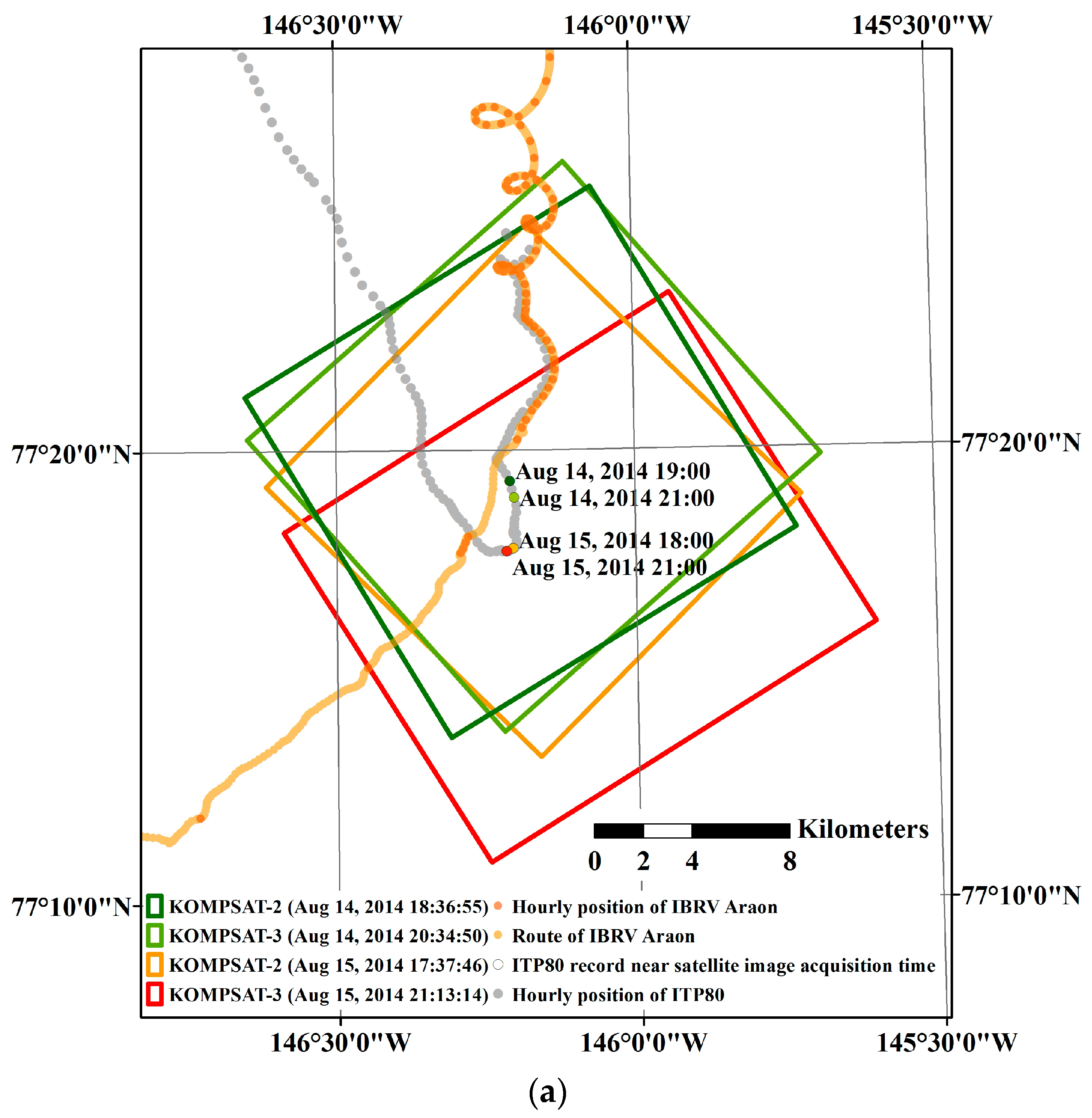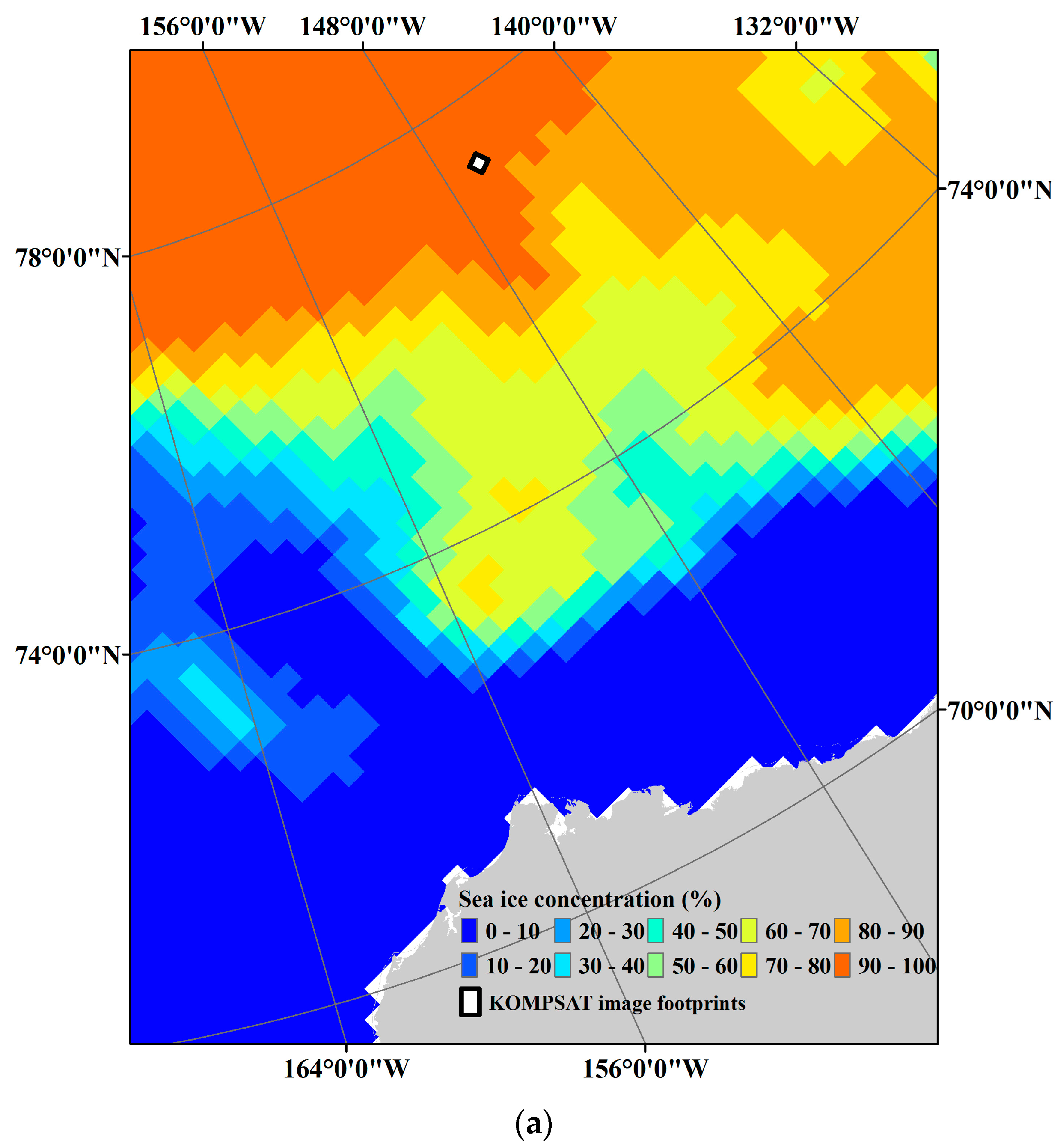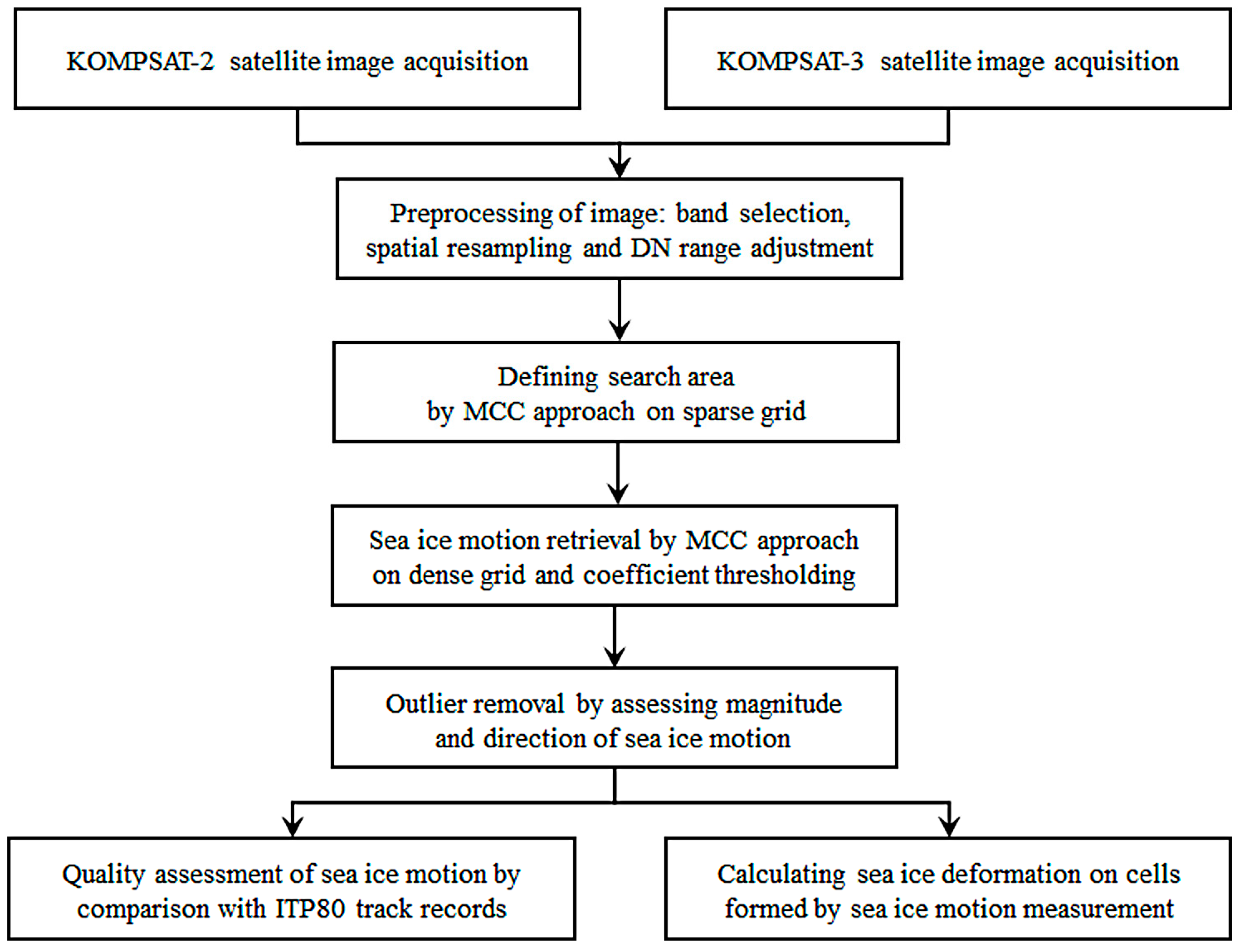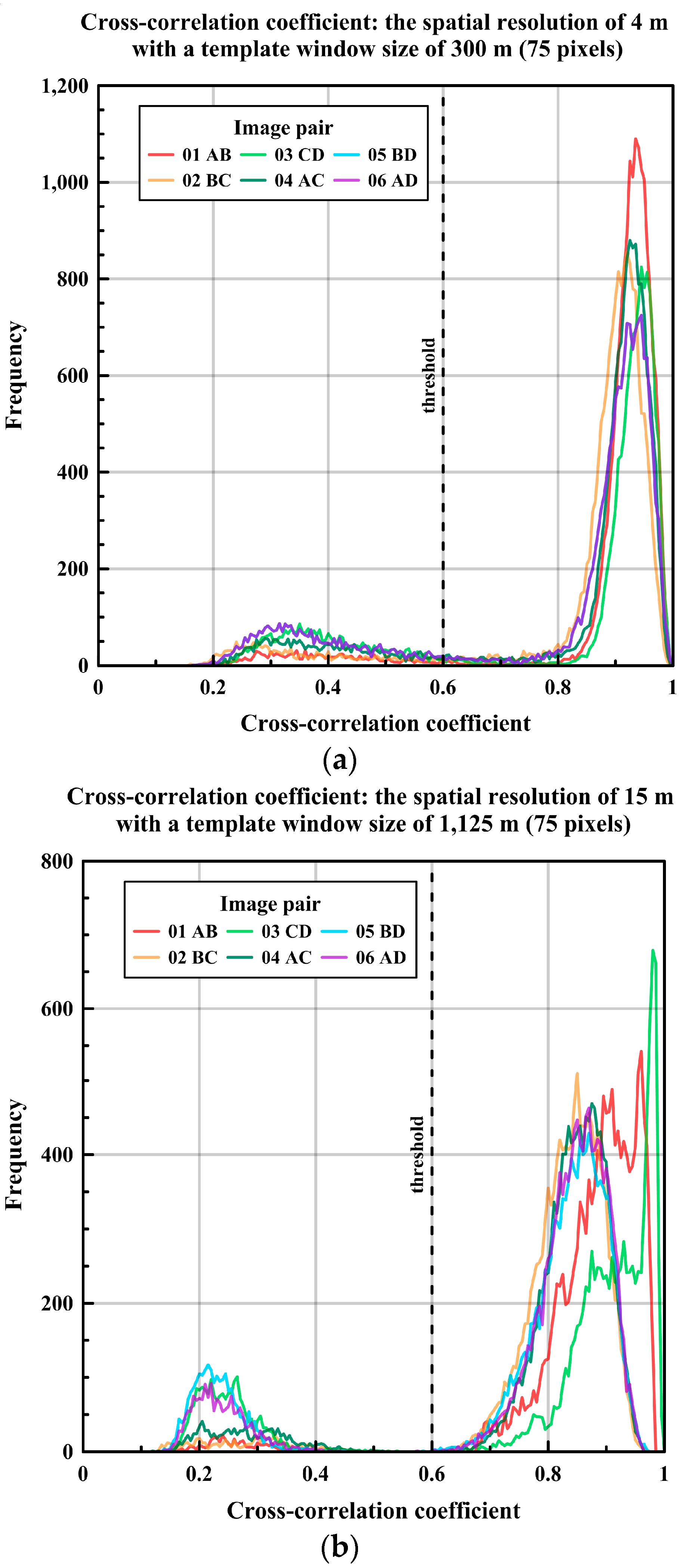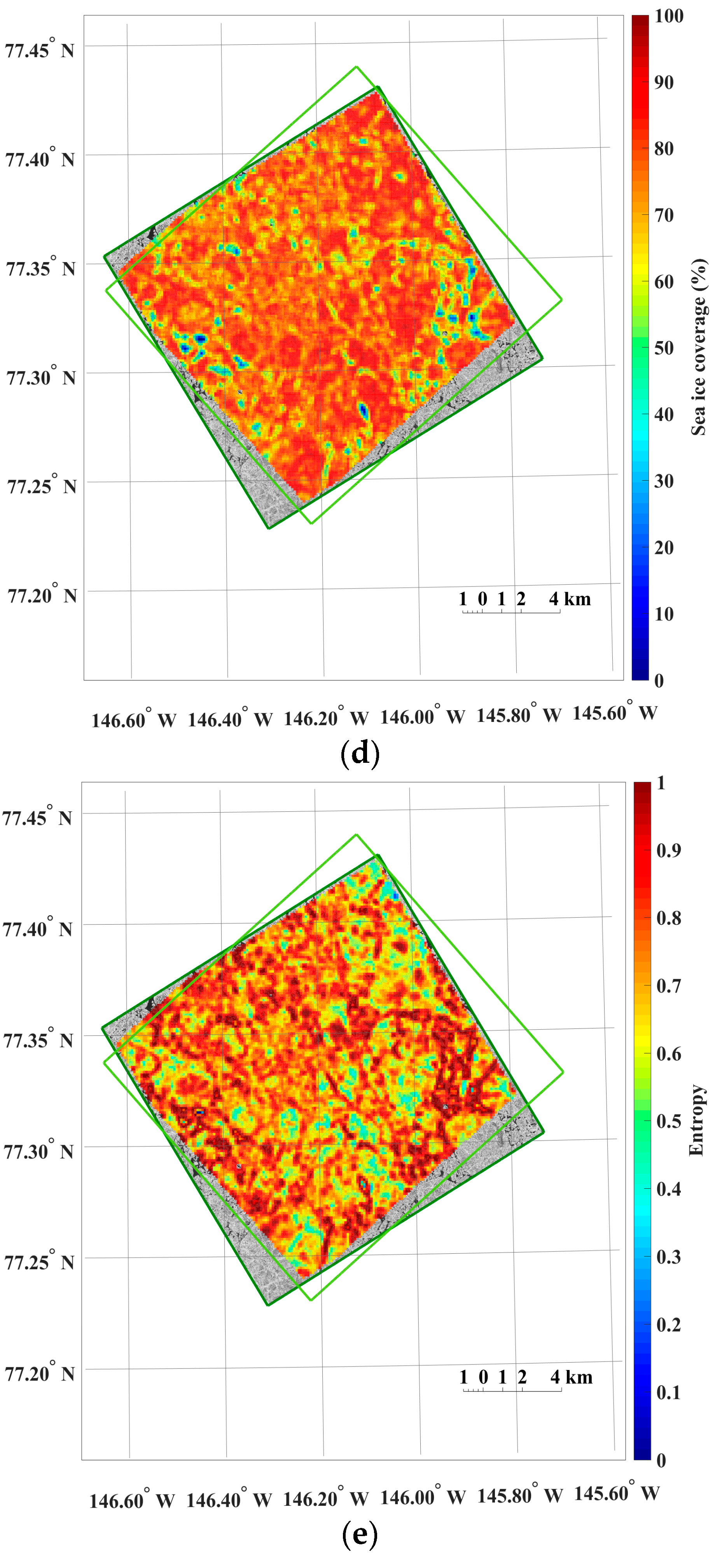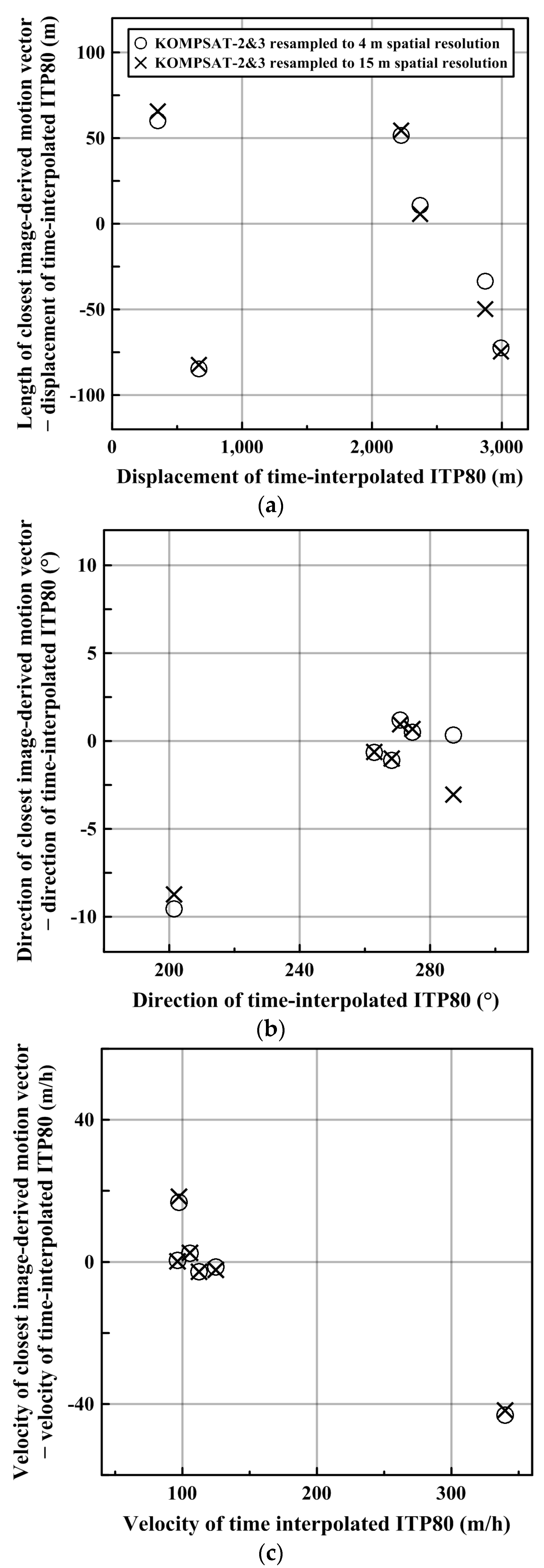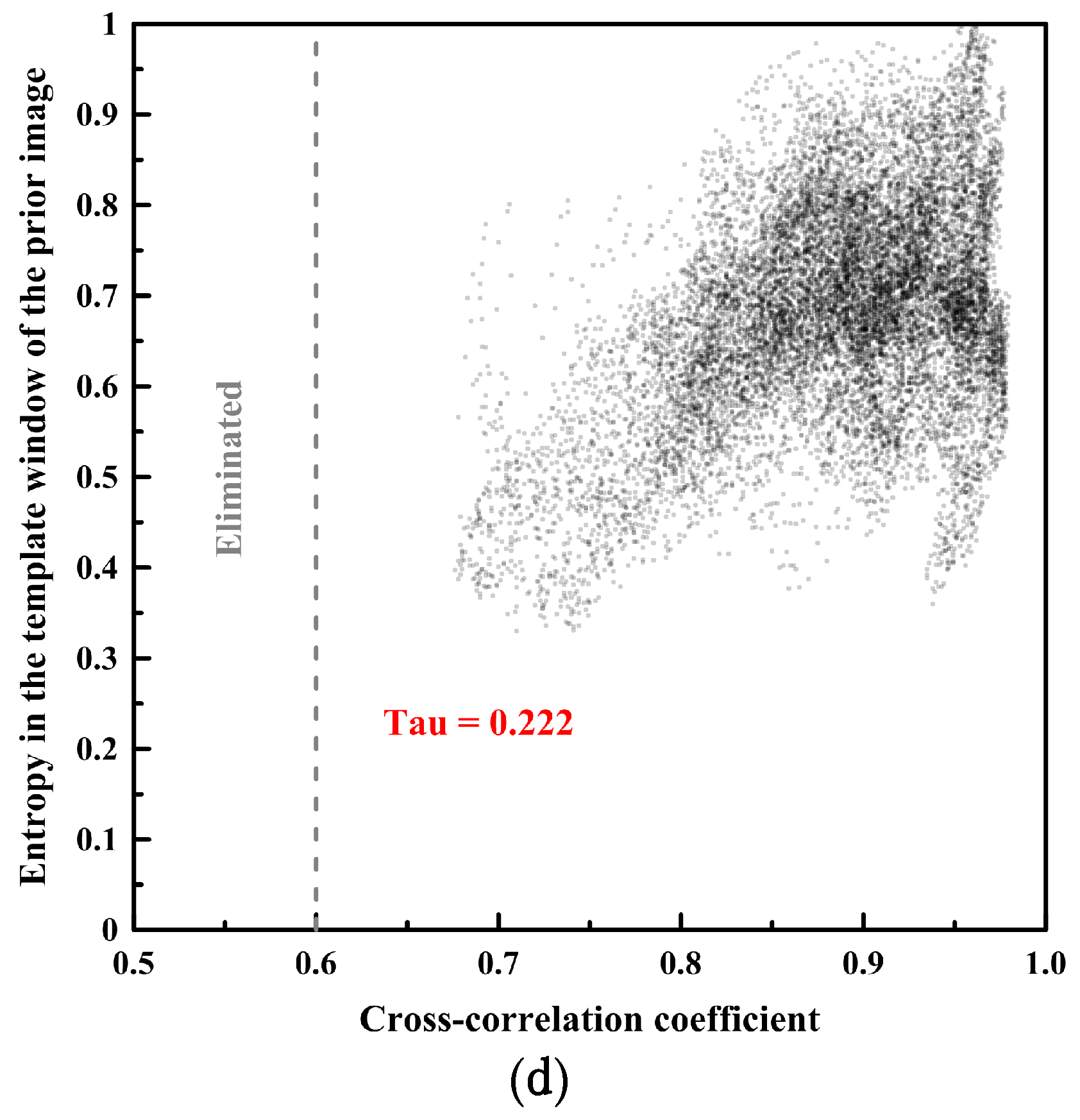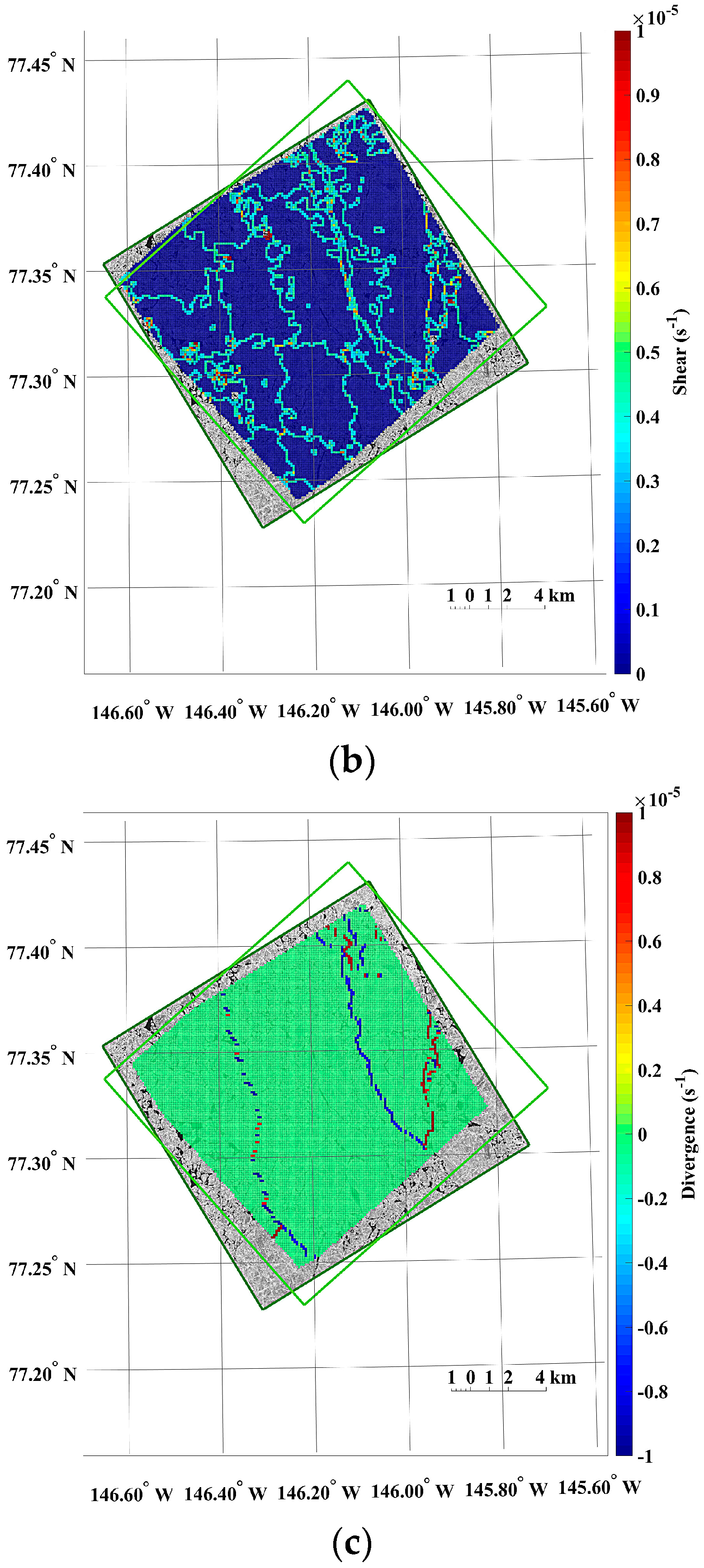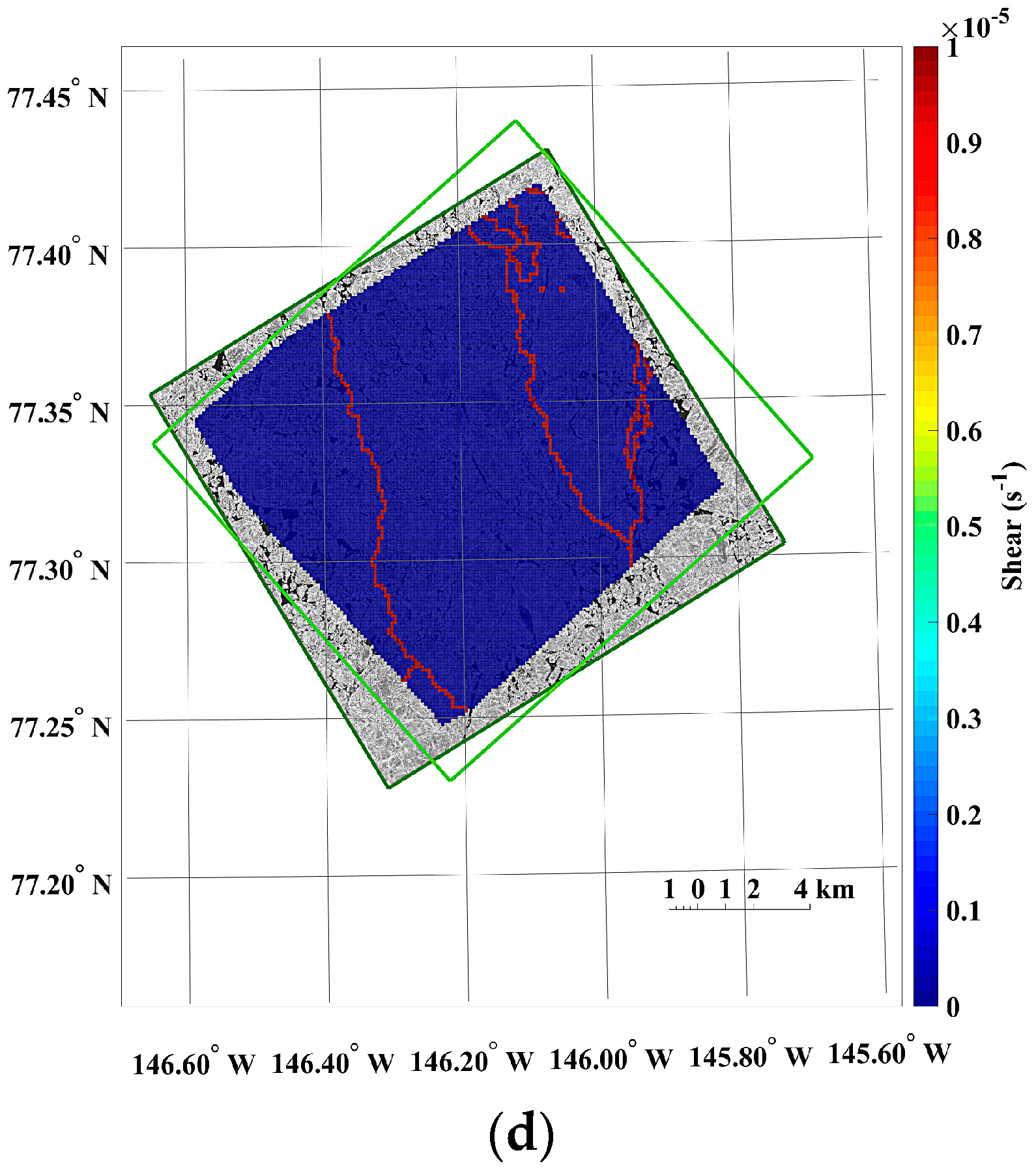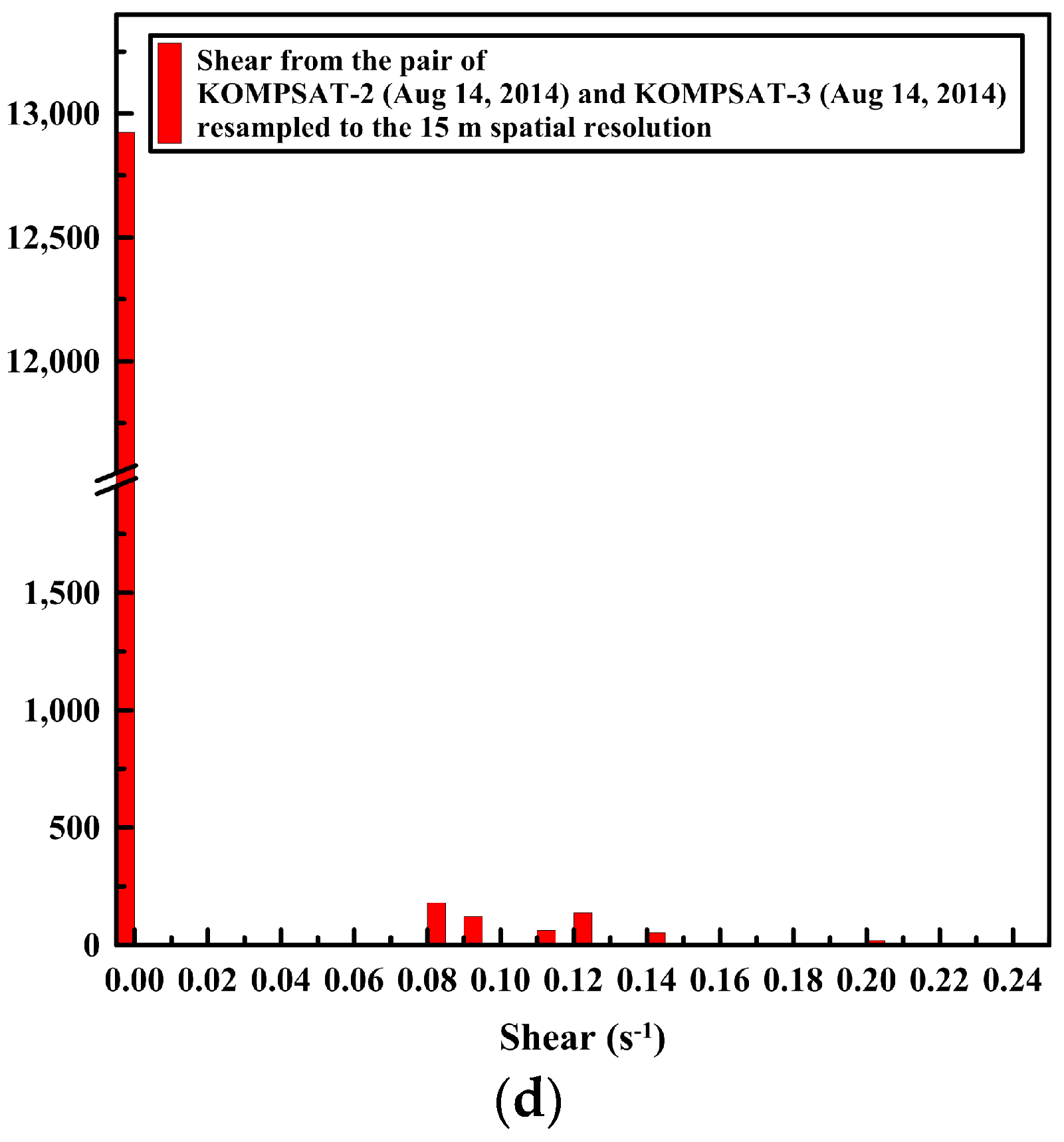1. Introduction
Sea ice motion and deformation measured from satellite remote sensing have played a significant role in understanding the dynamic polar climate system and to predict its ongoing and further long-term changes. Sea ice motion has been measured using low-resolution (e.g., a spatial resolution of 1 km or larger pixel size) satellite remote sensing datasets such as passive microwave data (e.g., Scanning Multichannel Microwave Radiometer (SMMR) [
1], Special Sensor Microwave/Imager (SSM/I) [
1,
2,
3,
4,
5] and Advanced Microwave Scanning Radiometer for the Earth Observing System (EOS) (AMSR-E) [
4,
6,
7]) and optical image data (e.g., Advanced Very High Resolution Radiometer (AVHRR) [
8,
9]) from a regional-scale (e.g., polynya or basin) to the entire Arctic or Southern Ocean.
Relatively higher spatial resolution satellite radar remote sensing with a spatial resolution from several tens of meters to around a hundred meters) has rarely been applied to the measurement of sea ice motion (e.g., RADARSAT Geophysical processor system (RGPS) [
10], GlobICE using Advanced Synthetic Aperture Radar (ASAR) on Envisat, with a spatial resolution of 150 m [
11], Envisat ASAR with a spatial resolution of 75 m [
12], and RADARSAT-2 ScanSAR of a spatial resolution of 100 m resampled from 50 m [
13]). These mid-resolution SAR successfully provided the products from polynya [
14] or basin-scale to the entire arctic coverage by systematic data acquisition plan. Radar remote sensing has been recognized as an optimum tool for sea ice motion retrieval because of its all-weather capability and day/night operation; however, operational sensors that can acquire data with proper revisit intervals are limited.
The representative and universal technique to measure sea ice motion by satellite remote sensing is by matching a block of prior images to a corresponding block of posterior images by choosing a maximum cross-correlation (MCC) coefficient, with consideration of the image acquisition time interval [
2,
4,
15]. The image blocks are usually matched in the areas where prominent and contrast features such as the boundary between ice and ocean are dominant. The drawback of the MCC approach is quantization noise, a degree of discreteness of the motion vector field, related to image pixel size [
4,
10].
Sea ice motion can be directly linked to sea ice deformation because the deformation is calculated from spatial gradients of motion [
16]. Therefore, satellite radar remote sensing with sub-daily to few days data acquisition intervals has been widely applied to measure the deformation [
16,
17]. Few sub-daily deformation measurements were reported in Reference [
18]; however, further studies regarding longer periods with short and continuous observation for more detailed understanding of the deformation as a mixture of inertial motion, tidal effect, and wind forcing are necessary [
19]. As low-contrast backscatter conditions on the sea ice surface during the melting season or sea ice edge area increases uncertainties in block matching between sequential images, the deformation data were commonly limited to the spring, fall and winter seasons [
7], or restricted on inner pack ice areas except ice margins [
16].
The possible utility of high-resolution optical satellite images for sea ice motion retrieval was suggested via visual inspection [
20]. High-resolution optical airborne observation was applied to measure high temporal and spatial resolution sea ice motion in near real-time [
21], but limited to coastal areas because of the coverage restriction of aerial survey. Small-scale kinematics (i.e., deformation) including opening and closing along the fractures in ice cover that can be connected to cracks exposing ocean and altering surface heat balance, and forcing ice into pressure ridges increasing drags between ice-ocean were detected from literal image derived product (LIDP), 1-m resolution panchromatic optical images [
22]. This application of high-resolution optical satellite images to sea ice deformation measurement provided smaller scale deformation than the mid-resolution radar remote sensing with spatial resolutions from several tens of meters to around a hundred meters [
10,
11,
12,
13,
14].
Measuring sea ice motion from the low-resolution satellite datasets have been validated using buoy location records [
23]. However, it is difficult to obtain the reference data for the validation because location records from buoy or ice drift station are sparse. To overcome deficiency of reference dataset, alternative validation approaches have been devised, e.g., assessing suitability of image blocks for matching [
24].
Nowadays, high-resolution optical imaging satellites have become more available. Moreover, earth observing near-polar orbit satellites have an advantage on more frequent visiting in high-latitude regions as trajectories converge around polar regions [
25]. Although optical satellite remote sensing is limited to cloud free conditions, combinations of sequential high-resolution optical images acquired from operational multiple sensors in high latitude regions can contribute to measuring long-term trends in ice motion, and can also be a reliable tool for monitoring sea ice in shipping lanes or in the vicinity of oil and gas platforms.
This study aimed to evaluate the feasibility of multi-sensor high-resolution optical satellite remote sensing for precise sea ice motion measuring using an MCC approach. To validate the measured sea ice motion, a comparison of the high- and resampled mid-resolution satellite image-derived sea ice motion with buoy trajectory was demonstrated, and causes of measurement errors (considering the effects from degraded spatial resolution) were investigated. Additionally, from the sea ice motion data, the sea ice deformation was estimated, and the applicability of the multi-sensor high-resolution optical satellite images for measuring kinematic characteristics of sea ice discussed.
5. Discussion
The results of the sea ice motion measurements illustrate that the dense distributions of the moving distance and direction from the image pairs of the 4 m spatial resolution revealed spatial patterns reflecting characteristics of sea ice motion (
Figure 5). Thus, from the high-resolution satellite image-derived spatial gradient pattern of the moving distance and direction, small-scale discontinuities in motion could be visualized. For the dataset spatially resampled to 15 m, the pixel aggregation during spatial resampling smoothed the surface texture of sea ice, so that effects from small scale irregular motions, e.g., isolated drifting floe, appeared to be decreased. Increased sea ice coverage, decreased entropy and slightly more discrete colors of the motion vectors in
Figure 8 when compared with
Figure 5, were from a relatively increased displacement unit caused by enlarged pixel size.
The displacements of the sea ice motion varied between 409.6 and 2921.4 m for the image pairs of the spatial resolution of 4 m and between 415.0 and 2919.1 m for the image pairs of the spatial resolution of 15 m, respectively. This means that the measured sea ice motions were larger than twice of the geolocation errors of the images, i.e., minimum detectable displacement between images, approximately 100 m. Thus, the sea ice motion can be considered to be partly affected by the geolocation errors of the images. When the images partly including land area over arctic coastal region are used for coastal and land fast sea ice motion measurement, geolocation errors of satellite sensors can be decreased by assigning ground control points to accurate geographic coordinates on land area. If other high-resolution spaceborne optical sensors of higher geolocation accuracy with few meters error are applied, more accurate sea ice motion and deformation measurements can be accomplished by decreasing minimum detectable displacement.
The RMSEs and biases of the sea ice motion parameters such as displacements, directions and velocities were known to be increased in coarser resolution datasets associated with extended unit distance of the images given the errors’ dependency on the spatial resolution [
17,
46], and changed image texture to less sensitive conditions for precise measurement from an enlarged spatial resolution. However, results regarding the sea ice motion showed similar RMSEs and biases for both resolution datasets.
The distances between the center of the selected motion vectors from the image pair of the spatial resolution of 4 m and the center of the corresponding time-interpolated ITP80 locations varied from 17.3–69.0 m, similarly, the distances extracted from the image pairs of the spatial resolution of 15 m varied from 10.3–70.8 m. From these distance ranges varying tens of meters, the selected image-derived motion vectors of both spatial resolutions were considered to be located on the same rigid plate where ITP80 located. Thus, the differences in the RMSEs and biases between the datasets was assumed to be affected by the compound of discretization uncertainty from different pixel sizes, GPS positioning uncertainty and errors from time-interpolated ITP80. Although the pixel size was enlarged from 4 to 15 m by pixel aggregation, the RMSEs and biases of displacements, directions and velocities did not degrade distinctly.
In addition to the discretization uncertainty, possible causes of errors inducing the RMSEs and biases were GPS positioning errors in the ITP80 location records and geolocation errors of the satellite images [
17]. The horizontal positioning error of GPS, e.g., the Navman Jupiter 21 GPS receiver used for some ITPs [
32], is known to be 5.2 m (2d RMS) [
47], and other kinds of receivers equipped in the ITPs may cause a similar number of positioning errors. The geolocation accuracy of the KOMPSAT-2 and KOMPSAT-3 satellite images assessed in December 2014 were reported as 62.8 m and 40.6 m CE90 (circular error at 90%), respectively [
48]. Although the errors in the sea ice motion were combined with the GPS positioning error of the ITP80, the geolocation error of the satellite images, and measurement unit (e.g., the sliding distance of template window or pixel size) of the MCC approach, the RMSEs of the sea ice motion measurement in this study were lower than previous studies using low-resolution remote sensing datasets (e.g., about 323 m for the RGPS using 100 m spatial resolution SAR data [
17] and about 3–12 km for low-resolution passive microwave data [
40]).
The cross-correlation coefficient and the sea ice coverage of the image blocks from the prior image showed negative correlations as negative Kendall’s tau coefficients in the image pairs of both spatial resolutions, indicating that lower sea ice concentration was more favorable as a condition to measure precise sea ice motion in the high sea ice concentration generally in the range of 90–100% SIC from NSIDC’s passive microwave remote sensing based data as in this study (
Table 6).
On the other hand, the cross-correlation coefficient and the entropy of the image blocks from the prior image showed positive correlations as positive Kendall’s tau coefficients in the image pairs of both spatial resolutions, indicating that higher complexity, i.e., combinations of smaller ice floe size, complicated boundary of ice floe, dense pressure edge and numerous melt pond, was a more favorable condition to measure precise sea ice motion (
Table 6). The use of a less saturated band image also prevented the hampering of precise matching in the high sea ice concentration conditions from dimming and flattening small-scale morphological features such as the pressure edge and its shadow on the sea ice surface.
In
Figure 10,
Figure 11 and
Figure 12, a higher entropy of the image blocks, which was a more favorable condition to measure sea ice motion using the MCC approach, was from sea ice coverages around 50%. This could be linked to the capability that enabled precise image block matching in sea ice melting season or sea ice edge area occupying a complex mixture of sea ice and open ocean using the multi-sensor high-resolution optical satellite images.
The results of the sea ice deformation measurements illustrate that prominent differences of the sea ice displacement lengths were revealed in the divergence (
Figure 13a), and individual floes as unit moving plates were clearly separated by high shear (
Figure 13b) from the image pairs of the 4 m spatial resolution. Thus, this small-scale deformation from high-resolution images can support understanding the interaction among individual ice floes, the aggregation of ice floes with over time, and the formation of leads or ridges [
49]. Conversely, the openings and closings, and shear between the ice floes were less detectable from the image pairs resampled to the spatial resolution of 15 m (
Figure 13) as the detailed ice floe moving was more homogenized from quantization to larger pixel size as quantization noise. The wider distributions of spiky peaks in the histograms of the divergence and shear in the image pairs resampled to the spatial resolution of 15 m (
Figure 14) also reflect less sensitivity of deformation measurement for the enlarged pixel size, indicating discretization uncertainty [
17]. Increased detection limits of deformations were also identifiable from the wider distribution of peaks in the histograms.
6. Conclusions
The feasibility of the sea ice motion measurement using the MCC technique and multi-temporal high-resolution optical satellite images from multi-sensors (which have become more available in polar regions with short acquisition time intervals) was tested. Although decreased complexity of image texture caused less favorable conditions for the MCC approach as it had overall lower cross-correlation coefficients, the sea ice motion extracted from the image pairs of the spatial resolution of 15 m yielded similar RMSEs and biases of the measurements to the image pairs resampled to the spatial resolution of 4 m as the dense motion vector field allowed the extraction of motion vectors for validations to be placed in the same rigid sea ice plate. The errors in the motion vector measurements were mainly affected by the geolocation error of the satellite images, and were improved compared with previous studies using low-resolution passive microwave or radar remote sensing datasets.
The small-scale kinematics observable from the dense sea ice motion field were affected by enlarged pixel size as the discretization uncertainty. The openings and closings between ice floes, and shear were less detectable from the image pairs resampled to the spatial resolution of 15 m, when compared with the image pairs resampled to the spatial resolution of 4 m.
Using multi-temporal high-resolution optical satellite images enabling precise image block matching (as shown in the results of this study) can be linked to the capability of specific or individual ice floe tracking that is applicable to validate wide-range sea ice motion modeling studies as a supplementary or alternative dataset to buoy based reference datasets. It has the further advantage of frequent image acquisition capability in multiple areas by means of multiple operational satellites, for example, the satellites of similar sensor characteristics such as Landsat-8 OLI and Sentinel-2; the satellites managed by same operator such as KOMPSATs; the satellites phased on the same orbit such as SPOT 6, SPOT 7, Pléiades 1A and Pléiades 1B; and identical satellites forming constellation in orbits such as RapidEye and PlanetScope. In further study, the sea ice motion and deformation measurements using high-resolution optical satellite images extending to a wider range of sea ice concentration conditions in a longer time period could expand the applicability of this approach to wider polar regions over a longer melting period.
